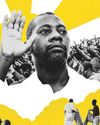The New Yorker Magazine - August 26, 2024

The New Yorker Magazine - August 26, 2024

Go Unlimited with Magzter GOLD
Read The New Yorker along with 9,000+ other magazines & newspapers with just one subscription View catalog
1 Month $9.99
1 Year$99.99 $49.99
$4/month
Subscribe only to The New Yorker
1 Year $99.99
1 Month $9.99
Buy this issue $8.99
In this issue
THE TALK OF THE TOWN
Amy Davidson Sorkin on Trump’s legal prospects; newspaper thefts; Chris Perfetti at the zoo; from the Nile to the Housatonic; bear suggestions.
A REPORTER AT LARGE
The Infiltrators - David D. Kirkpatrick
Tracking down right-wing extremists.
My Life's Work- All I have in the world is a paternal aunt and a tank of fish that love me. And my work. I'm nobody.
Who am I? I’m nobody. I was cut from every team in high school. I didn’t go to an Ivy League college.

3 mins
Sea Change- Mountains, oddly, are the reason most of us have learned to think of the level of the sea as a stable point, a baseline, an unmoving benchmark against which one might reasonably measure the height of great peaks.
In 2019, a plaque was erected to commemorate the first glacier in Iceland to shrink so much that it could no longer be considered a glacier. Like the tsunami stones of the past, the plaque carried a message for the future, a warning to believe in changes that might at first seem implausible. It also carried a recognition of responsibility. “In the next 200 years all our glaciers are expected to follow the same path,” the plaque reads. “This monument is to acknowledge that we know what is happening and what needs to be done. Only you know if we did it.”

10+ mins
THE INFILTRATORS
Who’ leading the way in investigating far-right extremists: FBI. agents or leftist vigilantes?

10+ mins
A Cult in the Forest - The vast majority of Kenyans are Christian, a faith that arrived with early colonization. A group of Finnish missionaries brought Pentecostalism in the nineteen-hundreds
The vast majority of Kenyans are Christian, a faith that arrived with early colonization. A group of Finnish missionaries brought Pentecostalism in the nineteen-hundreds. The colonial government tried to suppress it, because a faction of pro-independence freedom fighters belonged to the African Independent Pentecostal Church of Africa, which included messages about decolonization in its hymns. But after independence, in 1963, Pentecostalism and other forms of evangelical Christianity spread. They emphasized charismatic forms of worship—visions, spiritual healing, speaking in tongues—and a gospel that promised prosperity to the faithful. “If you want your church to be full, do what I call ‘spiritual gymnastics,’ ” Martin Olando, a scholar of African Christianity at the Bishop Hannington Institute, in Mombasa, told me. “Jump up and down, prophesize good tidings, tell people what they want to hear.” By the nineties, Kenya’s President, Daniel arap Moi, enjoyed a beneficial relationship with Arthur Kitonga, an influential Pentecostal bishop. “President Moi has been appointed by God to lead this country,” Kitonga said at the time. William Ruto, Kenya’s current President, and its first evangelical one, brought gospel singers into his campaign team and party, and has donated cars, and thousands of dollars, to evangelical churches. His wife, Rachel, invited the U.S.-based televangelist Benny Hinn to preach with her at a crusade. (This year, Hinn apologized for giving fake prophecies. “There were times when I thought God had showed me something that He wasn’t showing me,” he told the Christian podcast “Strang Report.”)

10+ mins
THE NARAYANS
Mrs. Narayan was small, dark-skinned, oval-faced. She had a wonderful singsong voice.

10+ mins
The Kamala Show
The evolution of Harris’ public persona.

9 mins
FUTURE IMPERFECT
“Hum,” Helen Phillips’s third novel, begins with a needle being drawn, steadily and irreversibly, across a woman named May’s face.

8 mins
OUT OF THE PAST
At the beginning of “The Spirit of the Beehive” (1973), Víctor Erice’s sublime first feature, a travelling projectionist arrives at a remote Castilian village, bearing a print of James Whale’s “Frankenstein.”

6 mins
The New Yorker Magazine Description:
Publisher: Condé Nast
Category: Culture
Language: English
Frequency: Weekly
The New Yorker is a weekly magazine that features journalism, commentary, criticism, essays, fiction, satire, cartoons, and poetry. It was founded in 1925 and is published by Condé Nast. The magazine is known for its in-depth reporting, its sharp and witty writing, and its iconic cartoons.
The New Yorker has a long and distinguished history. It has published some of the most important and influential writers of the 20th and 21st centuries, including Dorothy Parker, E.B. White, John Updike, Philip Roth, and Susan Sontag. The magazine has also won numerous awards, including the Pulitzer Prize for National Reporting.
The New Yorker is a must-read for anyone who wants to stay informed about current events and culture. It is also a great source of entertainment and thought-provoking essays.
Here are some of the things you can expect to find in The New Yorker Magazine:
*In-depth reporting on current events, politics, and culture
*Sharp and witty commentary on the news and the world around us
*Essays on a wide range of topics, from personal experiences to philosophical musings
*Fiction by some of the best writers in the world
*Satire and cartoons that poke fun at the powerful and the ridiculous
If you are looking for a magazine that is intelligent, informative, and entertaining, then The New Yorker is the magazine for you. It is a magazine that has something to offer everyone.
 Cancel Anytime [ No Commitments ]
Cancel Anytime [ No Commitments ] Digital Only
Digital Only